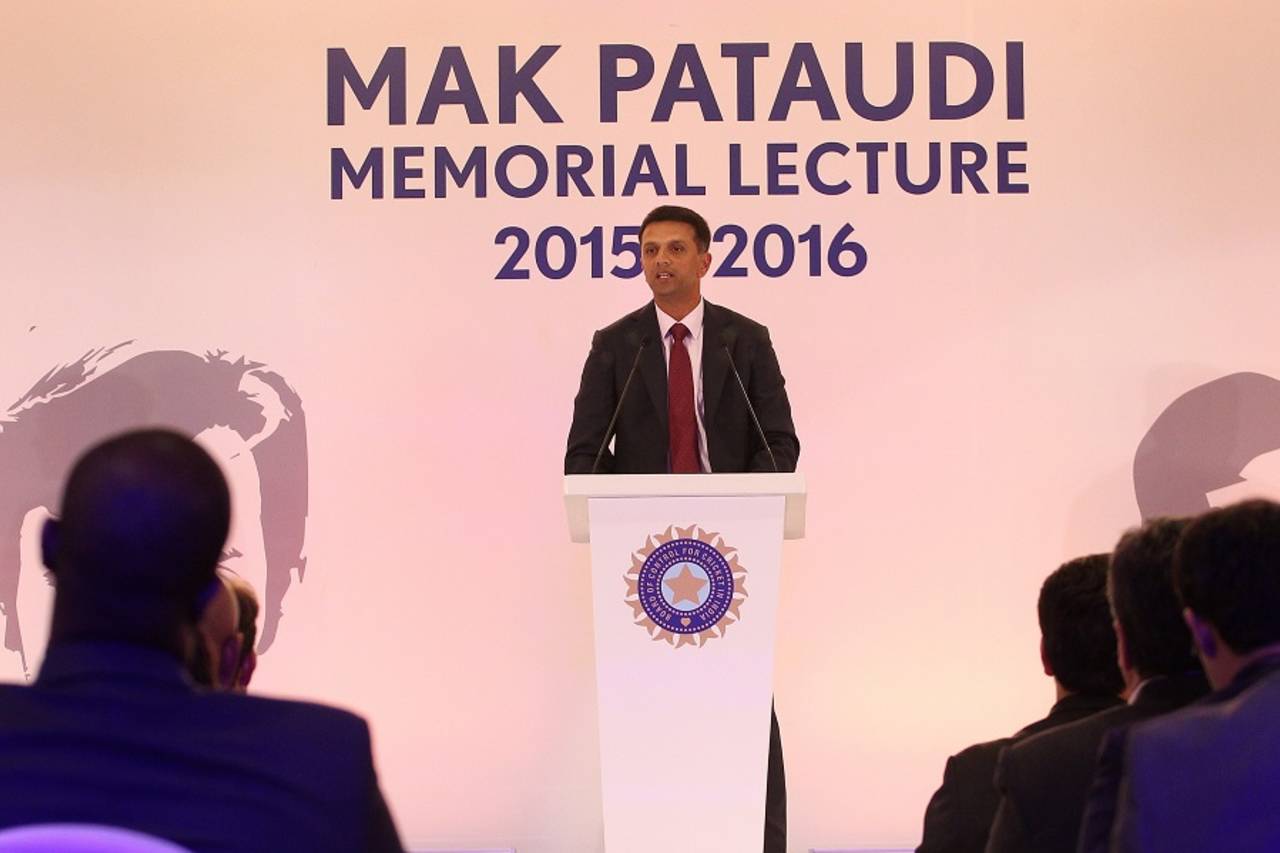Former India captain
Rahul Dravid has said that the "scourge of overage players" in Indian junior cricket is no different to "fixing and corruption". Delivering the fourth MAK Pataudi Memorial lecture in Delhi, Dravid said age-fudging was a "toxic" exercise and a "loophole" that could only be covered up if the BCCI and state associations regulated the privately-run academies and made it mandatory for players to submit valid birth certificates.
"I think of this overage business as dangerous and even toxic and to me, gives rise to a question: If a child sees his parents and coaches cheating and creating a fake birth certificate, will he not be encouraged to become a cheat? He is being taught to lie by his own elders," Dravid said to a gathering which included former Indian captains Sunil Gavaskar, Bishen Singh Bedi, Ajit Wadekar, Mohammad Azharuddin, Anil Kumble and the Indian and South African squads. "At 14, it may be in the matter of the age criteria, at 25 it may be fixing and corruption. How are the two different in any way? In both cases, is it not blatant cheating?"
During the course of a speech that lasted exactly half an hour, Dravid felt a player's support system - parents and his coach - agree to age-fudging even with the risk of being found out. A factor of even greater concern, according to him, was that a promising young player who meets the proper criteria misses out.
"Like the issue of bowling actions, it is a similar emphasis on short-term results that has led to the scourge of overage players in junior matches," Dravid explained. "That entire exercise begins when a coach alters a player's date of birth so that he can take part in a local tournament. The parents are happy to accept the value of an extra year or two, particularly in junior cricket and, academically at middle school.
"The truth is that the player who has faked his age might make it at the junior level not necessarily because he is better or more talented, but because he is stronger and bigger. We all know how much of a difference a couple of years can make at that age. That incident will have another ripple effect: an honest player deprived of his place by an overage player, is disillusioned. We run the risk of losing him forever."
Dravid held nothing back and called these overaged players "guilty." He then praised the BCCI for conducting bone density tests to eradicate the problem, and suggested that the board and every state association maintain a record of valid birth certificates for each player in a central database.
"It is not that nothing has been done to identify the guilty - and I do think of them as guilty," Dravid said. "Like, in the KSCA, a child's birth certificate is valid only if it is dated within two years of the child's birth. The BCCI's bone density test is an excellent introduction, but even if it discovers that a child wanting to play in an Under-16 competition doesn't meet the stipulated criteria, there is nothing done to ensure that the child's birth date is reviewed or corrected so that he doesn't slip through the system and turn up as a 20-year-old trying to get into an Under-19 tournament after a few years."
Dravid said another option was to provide licenses to the numerous privately-run academies around the country. "How can we work through this loophole? Those minimum standards guidelines to academies that I spoke about earlier, perhaps could also state a demand that academies need to collect birth certificates of every aspiring young cricketer and have it recorded into the larger state association database of registered players."
Serious in tone and delivery, the major part of Dravid's speech, or in his own words "a lecture" dealt with how the administrators and others involved with the game needed to keep future generations interested in cricket.
"I strongly believe that these young kids are the first generation of Indians who could be growing up without a deep personal connection to the game," he said. "Today's children have many, many other options. They will grow up to be the thought leaders and opinion makers and fund managers. It is why Indian cricket must reintroduce its children to the game and its magic all over again. They are a very, very serious audience."
At the outset Dravid declared that he was a modern-day parent. He has two young children, one of whom has just started playing age-group cricket. He is also the India A and Under-19 coach.
Calling himself a post-1983 World Cup generation kid, for whom cricket and cinema were the two preferred leisure activities, Dravid said that for today's generation cricket did not hold the same appeal, and was not their first game of choice. "The generation when every Indian baby is born with a cricket bat in the hand is well behind us," he said.
The reason Dravid chose this topic for the MAK Pataudi lecture was, "I believe in it passionately - that we need to invest as much energy, time and focus into India's youngest cricketers as we do for those at the elite level."
Nagraj Gollapudi is an assistant editor at ESPNcricinfo
